Cover
Copyright
Credits
About the Author
About the Reviewers
www.PacktPub.com
Table of Contents
Preface
Chapter 1: Introducing Machine Learning
The origins of machine learning
Uses and abuses of machine learning
Ethical considerations
How do machines learn?
Abstraction and knowledge representation
Generalization
Assessing the success of learning
Steps to apply machine learning
to your data
Choosing a machine learning algorithm
Thinking about the input data
Thinking about types of machine learning algorithms
Matching your data to an appropriate algorithm
Using R for machine learning
Installing and loading R packages
Installing an R package
Installing a package using the point-and-click interface
Loading an R package
Summary
Chapter 2: Managing and
Understanding Data
R data structures
Vectors
Factors
Lists
Data frames
Matrixes and arrays
Managing data with R
Saving and loading R data structures
Importing and saving data from CSV files
Importing data from SQL databases
Exploring and understanding data
Exploring the structure of data
Exploring numeric variables
Measuring the central tendency – mean and median
Measuring spread – quartiles and the
five-number summary
Visualizing numeric variables – boxplots
Visualizing numeric variables – histograms
Understanding numeric data – uniform and
normal distributions
Measuring spread – variance and standard deviation
Exploring categorical variables
Measuring the central tendency – the mode
Exploring relationships between variables
Visualizing relationships – scatterplots
Examining relationships – two-way
cross-tabulations
Summary
Chapter 3: Lazy Learning – Classification
using Nearest Neighbors
Understanding classification using nearest neighbors
The kNN algorithm
Calculating distance
Choosing an appropriate k
Preparing data for use with kNN
Why is the kNN algorithm lazy?
Diagnosing breast cancer with the
kNN algorithm
Step 1 – collecting data
Step 2 – exploring and preparing the data
Transformation – normalizing numeric data
Data preparation – creating training and
test datasets
Step 3 – training a model on the data
Step 4 – evaluating model performance
Step 5 – improving model performance
Transformation – z-score standardization
Testing alternative values of k
Summary
Chapter 4: Probabilistic
Learning – Classification using Naive Bayes
Understanding naive Bayes
Basic concepts of Bayesian methods
Probability
Joint probability
Conditional probability with Bayes' theorem
The naive Bayes algorithm
The naive Bayes classification
The Laplace estimator
Using numeric features with naive Bayes
Example – filtering mobile phone spam with the naive Bayes algorithm
Step 1 – collecting data
Step 2 – exploring and preparing the data
Data preparation – processing text data
for analysis
Data preparation – creating training and
test datasets
Visualizing text data – word clouds
Data preparation – creating indicator features for frequent words
Step 3 – training a model on the data
Step 4 – evaluating model performance
Step 5 – improving model performance
Summary
Chapter 5: Divide and
Conquer – Classification using Decision Trees
and Rules
Understanding decision trees
Divide-and-conquer
The C5.0 decision tree algorithm
Choosing the best split
Pruning the decision tree
Example – identifying risky bank loans using C5.0 decision trees
Step 1 – collecting data
Step 2 – exploring and preparing the data
Data preparation – creating random training and test datasets
Step 3 – training a model on the data
Step 4 – evaluating model performance
Step 5 – improving model performance
Boosting the accuracy of decision trees
Making some mistakes more costly than others
Understanding classification rules
Separate-and-conquer
The One Rule algorithm
The RIPPER algorithm
Rules from decision trees
Example – identifying poisonous mushrooms with rule learners
Step 1 – collecting data
Step 2 – exploring and preparing the data
Step 3 – training a model on the data
Step 4 – evaluating model performance
Step 5 – improving model performance
Summary
Chapter 6: Forecasting Numeric
Data – Regression Methods
Understanding regression
Simple linear regression
Ordinary least squares estimation
Correlations
Multiple linear regression
Example – predicting medical expenses using linear regression
Step 1 – collecting data
Step 2 – exploring and preparing the data
Exploring relationships among
features – correlation matrix
Visualizing relationships among
features – scatterplot matrix
Step 3 – training a model on the data
Step 4 – evaluating model performance
Step 5 – improving model performance
Model specification – adding non-linear relationships
Transformation – converting a numeric variable to
a binary indicator
Model specification – adding interaction effects
Putting it all together – an improved regression model
Understanding regression trees and model trees
Adding regression to trees
Example – estimating the quality of wines with regression trees and model trees
Step 1 – collecting data
Step 2 – exploring and preparing the data
Step 3 – training a model on the data
Visualizing decision trees
Step 4 – evaluating model performance
Measuring performance with mean absolute error
Step 5 – improving model performance
Summary
Chapter 7: Black Box Methods – Neural Networks and Support
Vector Machines
Understanding neural networks
From biological to artificial neurons
Activation functions
Network topology
The number of layers
The direction of information travel
The number of nodes in each layer
Training neural networks with backpropagation
Modeling the strength of concrete
with ANNs
Step 1 – collecting data
Step 2 – exploring and preparing the data
Step 3 – training a model on the data
Step 4 – evaluating model performance
Step 5 – improving model performance
Understanding Support Vector Machines
Classification with hyperplanes
Finding the maximum margin
The case of linearly separable data
The case of non-linearly separable data
Using kernels for non-linear spaces
Performing OCR with SVMs
Step 1 – collecting data
Step 2 – exploring and preparing the data
Step 3 – training a model on the data
Step 4 – evaluating model performance
Step 5 – improving model performance
Summary
Chapter 8: Finding Patterns – Market Basket Analysis using Association Rules
Understanding association rules
The Apriori algorithm for association
rule learning
Measuring rule interest – support and confidence
Building a set of rules with the Apriori principle
Example – identifying frequently purchased groceries with
association rules
Step 1 – collecting data
Step 2 – exploring and preparing the data
Data preparation – creating a sparse matrix for transaction data
Visualizing item support – item frequency plots
Visualizing the transaction data – plotting the sparse matrix
Step 3 – training a model on the data
Step 4 – evaluating model performance
Step 5 – improving model performance
Sorting the set of association rules
Taking subsets of association rules
Saving association rules to a file or data frame
Summary
Chapter 9: Finding Groups of
Data – Clustering
with k-means
Understanding clustering
Clustering as a machine learning task
The k-means algorithm for clustering
Using distance to assign and update clusters
Choosing the appropriate number of clusters
Finding teen market segments using
k-means clustering
Step 1 – collecting data
Step 2 – exploring and preparing the data
Data preparation – dummy coding missing values
Data preparation – imputing missing values
Step 3 – training a model on the data
Step 4 – evaluating model performance
Step 5 – improving model performance
Summary
Chapter 10: Evaluating Model Performance
Measuring performance for classification
Working with classification prediction data in R
A closer look at confusion matrices
Using confusion matrices to measure performance
Beyond accuracy – other measures of performance
Kappa statistic
Sensitivity and specificity
Precision and recall
The F-measure
Visualizing performance tradeoffs
ROC curves
Estimating future performance
The holdout method
Cross-validation
Bootstrap sampling
Summary
Chapter 11: Improving Model Performance
Tuning stock models for better performance
Using caret for automated parameter tuning
Creating a simple tuned model
Customizing the tuning process
Improving model performance with
meta-learning
Understanding ensembles
Bagging
Boosting
Random forests
Training random forests
Evaluating random forest performance
Summary
Chapter 12: Specialized Machine Learning Topics
Working with specialized data
Getting data from the Web with RCurl
Reading and writing XML with 'XML'
Reading and writing JSON with rjson
Reading and writing Microsoft Excel spreadsheets using xlsx
Working with bioinformatics data
Working with social network or graph data
Improving the performance of R
Managing very large datasets
Making data frames faster with data.table
Creating disk-based data frames with ff
Using massive matrices with bigmemory
Learning faster with parallel computing
Measuring execution time
Working in parallel with foreach
Using a multitasking operating system
with multicore
Networking multiple workstations with snow
and snowfall
Parallel cloud computing with MapReduce
and Hadoop
GPU computing
Deploying optimized learning algorithms
Building bigger regression models with biglm
Growing bigger and faster random forests
with bigrf
Training and evaluating models in parallel
with caret
Summary
Index
















 2023年江西萍乡中考道德与法治真题及答案.doc
2023年江西萍乡中考道德与法治真题及答案.doc 2012年重庆南川中考生物真题及答案.doc
2012年重庆南川中考生物真题及答案.doc 2013年江西师范大学地理学综合及文艺理论基础考研真题.doc
2013年江西师范大学地理学综合及文艺理论基础考研真题.doc 2020年四川甘孜小升初语文真题及答案I卷.doc
2020年四川甘孜小升初语文真题及答案I卷.doc 2020年注册岩土工程师专业基础考试真题及答案.doc
2020年注册岩土工程师专业基础考试真题及答案.doc 2023-2024学年福建省厦门市九年级上学期数学月考试题及答案.doc
2023-2024学年福建省厦门市九年级上学期数学月考试题及答案.doc 2021-2022学年辽宁省沈阳市大东区九年级上学期语文期末试题及答案.doc
2021-2022学年辽宁省沈阳市大东区九年级上学期语文期末试题及答案.doc 2022-2023学年北京东城区初三第一学期物理期末试卷及答案.doc
2022-2023学年北京东城区初三第一学期物理期末试卷及答案.doc 2018上半年江西教师资格初中地理学科知识与教学能力真题及答案.doc
2018上半年江西教师资格初中地理学科知识与教学能力真题及答案.doc 2012年河北国家公务员申论考试真题及答案-省级.doc
2012年河北国家公务员申论考试真题及答案-省级.doc 2020-2021学年江苏省扬州市江都区邵樊片九年级上学期数学第一次质量检测试题及答案.doc
2020-2021学年江苏省扬州市江都区邵樊片九年级上学期数学第一次质量检测试题及答案.doc 2022下半年黑龙江教师资格证中学综合素质真题及答案.doc
2022下半年黑龙江教师资格证中学综合素质真题及答案.doc